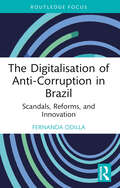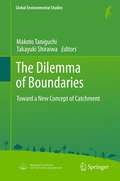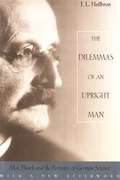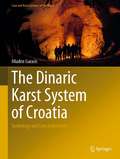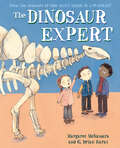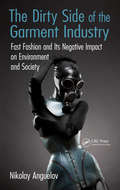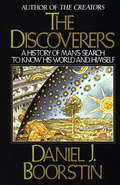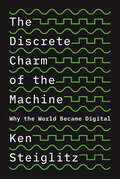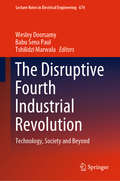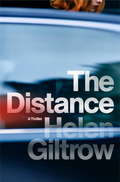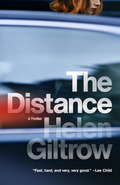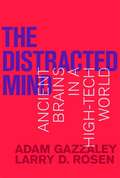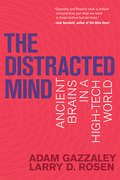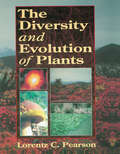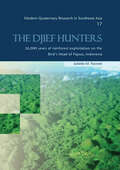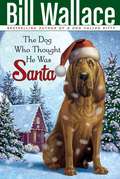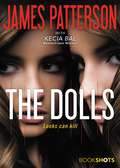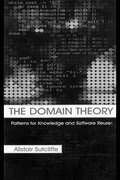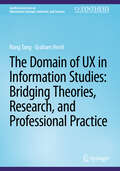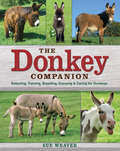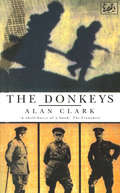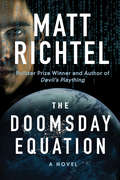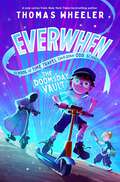- Table View
- List View
The Digitalisation of Anti-Corruption in Brazil: Scandals, Reforms, and Innovation (ISSN)
by Fernanda OdillaThis book investigates how digital technologies, such as social media and artificial intelligence, can contribute to combatting corruption in Brazil.Brazil, with its long history of scandals and abundant empirical data on digital media usage, serves as a perfect case study to trace the development of bottom-up and top-down digital anti-corruption technologies and their main features. This book highlights the connections between anti-corruption reforms and the rapid implementation of innovative solutions, primarily developed by tech-savvy public officials and citizens committed to anti-corruption efforts. The book draws on interviews with experts, activists and civil servants, as well as open-source materials and social media data to identify key actors, their practices, challenges and limitations of anti-corruption technologies. The result is a thorough analysis of the process of digitalisation of anti-corruption in Brazil, with a theoretical framework which can also be applied to other countries. The book introduces the concept of “integrity techies” to encompass social and political actors who develop and facilitate anti-corruption technologies, and discusses different outcomes and issues associated with digital innovation in anti-corruption.This book will be a key resource for students, researchers and practitioners interested in technologies and development in Brazil and Latin America, as well as corruption and anti-corruption studies more broadly.
The Dilemma of Boundaries
by Makoto Taniguchi Takayuki ShiraiwaWater circulates continuously and seamlessly on Earth with little regard for the boundaries we draw. There are natural boundaries as between land and ocean and surface and subsurface environments, as well as human or demographic boundaries between nations, cultures, and religions. Although considered necessary by societies, these human-created boundaries disrupt natural water circulation, leading to serious water-related environmental problems. The dilemma of how to manage water beyond our boundaries remains, and nations have different ways and means of controlling each form of water, whether as vapor, surface water, groundwater, or seawater. Recent findings on the interaction of water from land, oceans, and the atmosphere encourage researchers to undertake collaborative work that goes beyond the boundaries of each discipline, be it oceanography, surface and subsurface hydrology, climatology, or glaciology. Drawing on all these fields, the book focuses on two major boundaries: that between surface water and ground water, and that between terrestrial water and ocean water. This comprehensive work is of great value to experts in academia, international organizations, consulting firms, water resources, fisheries, and urban development planning agencies.
The Dilemmas of an Upright Man: Max Planck and the Fortunes of German Science, With a New Afterword
by J. L. HeilbronIn this moving and eloquent portrait, Heilbron describes how the founder of quantum theory rose to the pinnacle of German science. He shows how Planck suffered morally and intellectually as his lifelong habit of service to his country and to physics was confronted by the realities of World War I and the brutalities of the Third Reich.
The Dinaric Karst System of Croatia: Speleology and Cave Exploration (Cave and Karst Systems of the World)
by Mladen GarasicThis book offers readers a thorough introduction to the Dinaric Karst System in Croatia. As the first comprehensive book on the country’s caves and karst, it presents a wealth of fascinating photographs from its karst underground. To date, ca. 12,000 caves and pits have been confirmed in Croatia, approximately 35% of which contain constant groundwater. Knowing the amount, direction and quality of groundwater that has been discovered in caves of the Croatian karst allows us to predict with greater certainty the hydrogeological situation of some karst areas where no special drilling or borehole measurements were performed.In the process of building highways in the country’s karst regions over the last thirty years, thousands of caverns (speleological features without natural entrances) were discovered and thoroughly explored. All of them were geologically mapped, surveyed, and photographed in detail. Extensive research was systematically carried out in Croatian karst regions on sections of roads, highways, cuttings, slides, tunnels, bridge foundations, viaducts, etc., while creating ca. 800 kilometers of highways (such as the Zagreb-Rijeka highway, Zagreb-Split-Dubrovnik highway, Y-Ipsilon of Istria semi-highway, Rijeka-Rupa highway, Zagreb-Zadar semi-highway, and the Rijeka bypass). Some of these caverns contain major chambers like in the “Sveti Rok” tunnel and in some of them, like in the “Vrata” tunnel, it was even necessary to build a bridge. This bridge is the longest one in the world built in a tunnel over a cavern.The book describes this and many more features of the cave exploration of the Dinaric Karst System of Croatia, making it a valuable resource for researchers, engineers, cavers, and all other readers interested in karst.
The Dinosaur Expert (Mr. Tiffin's Classroom Series)
by Margaret McNamaraJoin Mr. Tiffin and his students on a trip to a natural history museum and learn all about dinosaurs and the scientists who discovered them!Mr. Tiffin and his students are back in another picture book, and this time the focus is on dinosaur-loving Kimmy. During a field trip to the natural history museum, Kimmy is thrilled to share what she knows about the Stegosaurus and the Archaeopteryx and even the ginormous Titanosaurus. That changes when one of her classmates questions whether girls can be paleontologists. Kimmy starts to feel shy. What if they can't? What if no one wants to hear what she has to say? It will take some help from Mr. Tiffin--and from a famous scientist--for Kimmy to find her voice again.Join Mr. Tiffin's class as they learn about dinosaurs big and small, feathered and scaly, winged and ocean-dwelling. And root for Kimmy, the dinosaur expert . . . who might just learn something about herself.
The Dirty Side of the Garment Industry: Fast Fashion and Its Negative Impact on Environment and Society
by Nikolay AnguelovWhen thinking about lowering or changing consumption to lower carbon footprints, the obvious offenders come easily to mind: petroleum and petroleum products, paper and plastic, even food. But not clothes. Although the clothing industry is the second largest polluter after agriculture, most consumers do not think of clothes as a source of environmen
The Discoverers
by Daniel J. BoorstinAn original history of man's greatest adventure: his search to discover the world around him. In the compendious history, Boorstin not only traces man's insatiable need to know, but also the obstacles to discovery and the illusion that knowledge can also put in our way. Covering time, the earth and the seas, nature and society, he gathers and analyzes stories of the man's profound quest to understand his world and the cosmos.
The Discrete Charm of the Machine: Why the World Became Digital
by Ken SteiglitzThe genesis of the digital idea and why it transformed civilizationA few short decades ago, we were informed by the smooth signals of analog television and radio; we communicated using our analog telephones; and we even computed with analog computers. Today our world is digital, built with zeros and ones. Why did this revolution occur? The Discrete Charm of the Machine explains, in an engaging and accessible manner, the varied physical and logical reasons behind this radical transformation.The spark of individual genius shines through this story of innovation: the stored program of Jacquard’s loom; Charles Babbage’s logical branching; Alan Turing’s brilliant abstraction of the discrete machine; Harry Nyquist’s foundation for digital signal processing; Claude Shannon’s breakthrough insights into the meaning of information and bandwidth; and Richard Feynman’s prescient proposals for nanotechnology and quantum computing. Ken Steiglitz follows the progression of these ideas in the building of our digital world, from the internet and artificial intelligence to the edge of the unknown. Are questions like the famous traveling salesman problem truly beyond the reach of ordinary digital computers? Can quantum computers transcend these barriers? Does a mysterious magical power reside in the analog mechanisms of the brain? Steiglitz concludes by confronting the moral and aesthetic questions raised by the development of artificial intelligence and autonomous robots.The Discrete Charm of the Machine examines why our information technology, the lifeblood of our civilization, became digital, and challenges us to think about where its future trajectory may lead.
The Disruptive Fourth Industrial Revolution: Technology, Society and Beyond (Lecture Notes in Electrical Engineering #674)
by Tshilidzi Marwala Wesley Doorsamy Babu Sena PaulThe book explores technological advances in the fourth industrial revolution (4IR), which is based on a variety of technologies such as artificial intelligence, Internet of Things, machine learning, big data, additive printing, cloud computing, and virtual and augmented reality. Critically analyzing the impacts and effects of these disruptive technologies on various areas, including economics, society, business, government, labor, law, and environment, the book also provides a broad overview of 4IR, with a focus on technologies, to allow readers to gain a deeper understanding of the recent advances and future trajectories. It is intended for researchers, practitioners, policy-makers and industry leaders.
The Distance
by Helen GiltrowA dark, ultra-contemporary and relentlessly paced debut thriller about a London society woman trying to put her secret criminal past behind her--and the hit man who comes to her with an impossible job she can't refuse. Charlotte Alton is an elegant socialite. But behind the locked doors of her sleek, high-security apartment in London's Docklands, she becomes Karla. Karla's business is information. Specifically, making it disappear. She's the unseen figure who, for a commanding price, will cover a criminal's tracks. A perfectionist, she's only made one slip in her career: several years ago she revealed her face to a man named Simon Johanssen, an ex-special forces sniper turned killer-for-hire. After a mob hit went horrifically wrong, Johanssen needed to disappear, and Karla helped him. He became a regular client, and then one day, she stepped out of the shadows for reasons unclear to even herself. Now, after a long absence, Johanssen has resurfaced with a job, and he needs Karla's help again. The job is to take out an inmate--a woman--inside an experimental prison colony. But there's no record the target ever existed. That's not the only problem: the criminal boss from whom Johanssen has been hiding is incarcerated there. That doesn't stop him. It's Karla's job to get him out alive, and to do that she must uncover the truth. Who is this woman? Who wants her dead? Is the job a trap for Johanssen or for her? But every door she opens is a false one, and she's getting desperate to protect a man--a killer--to whom she's inexplicably drawn. Written in stylish, sophisticated prose, The Distance is a tense and satisfying debut in which every character, both criminal and law-abiding, wears 2 faces, and everyone is playing a double game.
The Distance
by Helen GiltrowA dark, ultra-contemporary, and relentlessly paced debut thriller about a London society woman trying to put her secret criminal past behind her, and the hit man who comes to her with an impossible job she can't refuse.Charlotte Alton is an elegant socialite. But behind the locked doors of her sleek, high-security apartment in London's Docklands, she becomes Karla. Karla's business is information. Specifically, making it disappear. She's the unseen figure who, for a commanding price, will cover a criminal's tracks. A perfectionist, she's only made one slip in her career--several years ago she revealed her face to a man named Simon Johanssen, an ex-special forces sniper turned killer-for-hire. After a mob hit went horrifically wrong, Johanssen needed to disappear, and Karla helped him. He became a regular client, and then, one day, she stepped out of the shadows for reasons unclear to even herself. Now, after a long absence, Johanssen has resurfaced with a job, and he needs Karla's help again. The job is to take out an inmate--a woman--inside an experimental prison colony. But there's no record the target ever existed. That's not the only problem: the criminal boss from whom Johanssen has been hiding is incarcerated there. That doesn't stop him. It's Karla's job to get him out alive, and to do that she must uncover the truth. Who is this woman? Who wants her dead? Is the job a trap for Johanssen or for her? But every door she opens is a false one, and she's getting desperate to protect a man--a killer--to whom she's inexplicably drawn. Written in stylish, sophisticated prose, The Distance is a tense and satisfying debut in which every character, both criminal and law-abiding, wears two faces, and everyone is playing a double game.
The Distance Cure: A History of Teletherapy
by Hannah ZeavinPsychotherapy across distance and time, from Freud&’s treatments by mail to crisis hotlines, radio call-ins, chatbots, and Zoom sessions.Therapy has long understood itself as taking place in a room, with two (or more) people engaged in person-to-person conversation. And yet, starting with Freud&’s treatments by mail, psychotherapy has operated through multiple communication technologies and media. These have included advice columns, radio broadcasts, crisis hotlines, video, personal computers, and mobile phones; the therapists (broadly defined) can be professional or untrained, strangers or chatbots. In The Distance Cure, Hannah Zeavin proposes a reconfiguration of the traditional therapeutic dyad of therapist and patient as a triad: therapist, patient, and communication technology. Zeavin tracks the history of teletherapy (understood as a therapeutic interaction over distance) and its metamorphosis from a model of cure to one of contingent help. She describes its initial use in ongoing care, its role in crisis intervention and symptom management, and our pandemic-mandated reliance on regular Zoom sessions. Her account of the &“distanced intimacy&” of the therapeutic relationship offers a powerful rejoinder to the notion that contact across distance (or screens) is always less useful, or useless, to the person seeking therapeutic treatment or connection. At the same time, these modes of care can quickly become a backdoor for surveillance and disrupt ethical standards important to the therapeutic relationship. The history of the conventional therapeutic scenario cannot be told in isolation from its shadow form, teletherapy. Therapy, Zeavin tells us, was never just a &“talking cure&”; it has always been a communication cure.
The Distracted Mind: Ancient Brains in a High-Tech World
by Adam Gazzaley Larry D. RosenMost of us will freely admit that we are obsessed with our devices. We pride ourselves on our ability to multitask -- read work email, reply to a text, check Facebook, watch a video clip. Talk on the phone, send a text, drive a car. Enjoy family dinner with a glowing smartphone next to our plates. We can do it all, 24/7! Never mind the errors in the email, the near-miss on the road, and the unheard conversation at the table. In The Distracted Mind, Adam Gazzaley and Larry Rosen -- a neuroscientist and a psychologist -- explain why our brains aren't built for multitasking, and suggest better ways to live in a high-tech world without giving up our modern technology. The authors explain that our brains are limited in their ability to pay attention. We don't really multitask but rather switch rapidly between tasks. Distractions and interruptions, often technology-related -- referred to by the authors as "interference" -- collide with our goal-setting abilities. We want to finish this paper/spreadsheet/sentence, but our phone signals an incoming message and we drop everything. Even without an alert, we decide that we "must" check in on social media immediately.Gazzaley and Rosen offer practical strategies, backed by science, to fight distraction. We can change our brains with meditation, video games, and physical exercise; we can change our behavior by planning our accessibility and recognizing our anxiety about being out of touch even briefly. They don't suggest that we give up our devices, but that we use them in a more balanced way.
The Distracted Mind: Ancient Brains in a High-Tech World
by Adam Gazzaley Larry D. RosenWhy our brains aren't built for media multitasking, and how we can learn to live with technology in a more balanced way."Brilliant and practical, just what we need in these techno-human times."—Jack Kornfield, author of The Wise HeartMost of us will freely admit that we are obsessed with our devices. We pride ourselves on our ability to multitask—read work email, reply to a text, check Facebook, watch a video clip. Talk on the phone, send a text, drive a car. Enjoy family dinner with a glowing smartphone next to our plates. We can do it all, 24/7! Never mind the errors in the email, the near-miss on the road, and the unheard conversation at the table. In The Distracted Mind, Adam Gazzaley and Larry Rosen—a neuroscientist and a psychologist—explain why our brains aren't built for multitasking, and suggest better ways to live in a high-tech world without giving up our modern technology.The authors explain that our brains are limited in their ability to pay attention. We don't really multitask but rather switch rapidly between tasks. Distractions and interruptions, often technology-related—referred to by the authors as “interference”—collide with our goal-setting abilities. We want to finish this paper/spreadsheet/sentence, but our phone signals an incoming message and we drop everything. Even without an alert, we decide that we “must” check in on social media immediately.Gazzaley and Rosen offer practical strategies, backed by science, to fight distraction. We can change our brains with meditation, video games, and physical exercise; we can change our behavior by planning our accessibility and recognizing our anxiety about being out of touch even briefly. They don't suggest that we give up our devices, but that we use them in a more balanced way.
The Diversity and Evolution of Plants
by Lorentz C. PearsonThis exciting new textbook examines the concepts of evolution as the underlying cause of the rich diversity of life on earth-and our danger of losing that rich diversity. Written as a college textbook, The Diversity and Evolution of Plants introduces the great variety of life during past ages, manifested by the fossil record, using a new natural classification system. It begins in the Proterozoic Era, when bacteria and bluegreen algae first appeared, and continues through the explosions of new marine forms in the Helikian and Hadrynian Periods, land plants in the Devonian, and flowering plants in the Cretaceous. Following an introduction, the three subkingdoms of plants are discussed. Each chapter covers one of the eleven divisions of plants and begins with an interesting vignette of a plant typical of that division. A section on each of the classes within the division follows. Each section describes where the groups of plants are found and their distinguishing features. Discussions in each section include phylogeny and classification, general morphology, and physiology, ecological significance, economic uses, and potential for research. Suggested readings and student exercises are found at the end of each chapter.
The Djief Hunters, 26,000 Years of Rainforest Exploitation on the Bird's Head of Papua, Indonesia: Modern Quaternary Research in Southeast Asia, volume 17
by Juliette M. PasveerTwo prehistoric cave sites on the Bird's Head of western New Guinea provide a detailed narrative of 26,000 years of human occupation of this area. During Late Pleistocene times, lower temperatures allowed a suite of montane animal species to descend onto the lowland Ayamaru Plateau. When the montane fauna receded during the subsequent climatic amel
The Dog Who Thought He Was Santa
by Bill WallaceThe Nose Knows Don Franklin's dog, Frank, is a bloodhound, so he can smell when something's wrong. And a lot seems to be wrong in Don's family. Mom and Dad are worried about money, especially with Christmas right around the corner and the threat of the mine closing. Don's worried because he's just discovered how dangerous Dad's job in the mine is. And they're all worried about getting Don's little sister, Susan, what she wants for Christmas, when she won't tell anyone but Santa Claus what it is. It looks as if Christmas might not be all that merry at the Franklins' house.But Christmas is a time for miracles, whether seen from a boy's perspective or a dog's -- and The Dog Who Thought He Was Santa looks at the Franklins' Christmas miracle from both.
The Dolls (BookShots)
by James Patterson Kecia BalThe Dolls are perfect lovers, perfect companions, perfect killers. Investigative reporter Lana Wallace has covered many crimes of passion in 10 years. But nothing will prepare her for the dark secrets of...The Dolls. BookShotsLIGHTNING-FAST STORIES BY JAMES PATTERSON Novels you can devour in a few hours Impossible to stop reading All original content from James Patterson
The Domain Theory: Patterns for Knowledge and Software Reuse
by Alistair Sutcliffe A.G. SutcliffeIs this book about patterns? Yes and no. It is about software reuse and representation of knowledge that can be reapplied in similar situations; however, it does not follow the classic Alexandine conventions of the patterns community--i.e. Problem- solution- forces- context- example, etc. Chapter 6 on claims comes close to classic patterns, and the whole book can be viewed as a patterns language of abstract models for software engineering and HCI. So what sort of patterns does it contain? Specifications, conceptual models, design advice, but sorry not code. Plenty of other C++ code pattern books (see PLOP series). Nearest relative in published patterns books are Fowler's (1995) Analysis Patterns: Reusable object models and Coad, North and Mayfield. What do you mean by a Domain Theory? Not domains in the abstract mathematical sense, but domains in the knowledge--natural language sense, close to the everyday meaning when we talk about the application domain of a computer system, such as car rental, satellite tracking, whatever. The book is an attempt to answer the question ' what are the abstractions behind car rental, satellite tracking' so good design solutions for those problems can be reused. I work in industry, so what's in it for me? A new way of looking at software reuse, ideas for organizing a software and knowledge reuse program, new processes for reusing knowledge in requirements analysis, conceptual modeling and software specification. I am an academic, should I be interested? Yes if your research involves software engineering, reuse, requirements engineering, human computer interaction, knowledge engineering, ontologies and knowledge management. For teaching it may be useful for Master courses on reuse, requirements and knowledge engineering. More generally if you are interested in exploring what the concept of abstraction is when you extend it beyond programming languages, formal specificati
The Domain of UX in Information Studies: Bridging Theories, Research, and Professional Practice (Synthesis Lectures on Information Concepts, Retrieval, and Services)
by Rong Tang Graham HerrliThis book bridges the gap between academic and applied User Experience (UX) research, offering a fresh perspective on uniting these two communities. Drawing from their extensive professional experience in both realms, the authors delve into the varying definitions, models, and methods that distinguish academic and applied UX practices. Through a thoughtful analysis of communication styles and research dissemination, the book highlights how the disconnect and differences hinder the progress in the UX field. More importantly, the authors emphasize the urgent need for greater integration between the academic and applied UX communities. To address this, the authors present a comprehensive framework for converging these perspectives, fostering collaboration and innovation. By bridging this divide, the book seeks to strengthen, advance, and empower the UX discipline, making it an essential resource for researchers, practitioners, and anyone invested in the future of UX. In addition, this book: Examines the concept of UX as defined in both academic and applied research settings, highlighting the gaps between the two Explains how inconsistent definitions, methods, and communication strategies hinder UX research progress Proposes actionable steps to bridge the gap between academic and applied UX, benefiting both communities
The Donkey Companion: Selecting, Training, Breeding, Enjoying & Caring for Donkeys
by Sue WeaverStrong, intelligent, dependable, friendly, and extremely versatile, donkeys are the perfect farm companion. Whether you use your animal to pull carts, till fields, or protect livestock, you’ll benefit from this practical and inspirational guide to working with and caring for your donkey. Providing expert advice on selecting the right breed for your needs, daily maintenance, training, and first aid, Sue Weaver also includes plenty of fun facts and charming donkey anecdotes. Raise a happy and healthy donkey!
The Donkeys
by Alan ClarkThe landmark exposé of incompetent leadership on the Western Front - why the British troops were lions led by donkeys On 26 September 1915, twelve British battalions – a strength of almost 10,000 men – were ordered to attack German positions in France. In the three-and-a-half hours of the battle, they sustained 8,246 casualties. The Germans suffered no casualties at all. Why did the British Army fail so spectacularly? What can be said of the leadership of generals? And most importantly, could it have all been prevented? In The Donkeys, eminent military historian Alan Clark scrutinises the major battles of that fateful year and casts a steady and revealing light on those in High Command - French, Rawlinson, Watson and Haig among them - whose orders resulted in the virtual destruction of the old professional British Army. Clark paints a vivid and convincing picture of how brave soldiers, the lions, were essentially sent to their deaths by incompetent and indifferent officers – the donkeys. ‘An eloquent and painful book... Clark leaves the impression that vanity and stupidity were the main ingredients of the massacres of 1915. He writes searingly and unforgettably’ Evening Standard
The Doomsday Equation
by Matt RichtelFrom the Pulitzer Prize-winning New York Times journalist comes a pulse-pounding technological thriller--as ingenious as the works of Michael Crichton and as irresistible as a summer blockbuster--in which one man has three days to prevent the outbreak of World War III and the world's annihilationWhat if you knew the world was going to end?What if no one believed you?Jeremy Stillwater is a genius with computers but not so much with people. Maddeningly self-righteous, he's alienated his girlfriend and infuriated his Silicon Valley financiers and the government agents who saw military promise in his innovation: a program that seemed to be able to predict war.Even Jeremy has begun to doubt the algorithm's capabilities. Then one day his computer has a message for him. War is coming. Three days and counting until massive nuclear conflict.Is it real? A malicious joke? A bug?Isolated yet relentless, Jeremy soon uncovers an ancient conspiracy of unspeakable danger. And it will take every bit of Jeremy's stubborn ingenuity to survive another minute, let alone save the world.
The Doomsday Vault (Everwhen School of Time Travel (and Other Odd Sciences))
by Thomas WheelerFrom the screenwriter of Academy Award–nominated Puss in Boots and Puss in Boots: The Last Wish comes an inventive middle grade adventure about an interdimensional school for time travelers perfect for fans of the Spy School and Mr. Lemoncello&’s Library series.When Bertie Wells accidentally creates a black hole in his bedroom in the year 1878, the last thing he expects is for a grown-up to step out. Darla Marconi comes with an offer: Bertie is invited to attend the EverWhen School of Time Travel and Other Odd Sciences. Not exactly thrilled at the idea, but not exactly having anything better to do, Bertie agrees. And that was only the first weird thing to happen to him that day. Thankfully, he's not alone—144 years in the future, math whiz Zoe Fuentes just accepted the same invitation, and 550 years in the past, Amelia da Vinci (yes, that da Vinci) has also decided to attend. Transported to 2024 for their first semester of school, these three must team up and work together in order to survive the year, including weathering a time paradox, solving the case of a disappearing dean, and uncovering the truth behind a shady intergalactic secret society. At least time is on their side!
